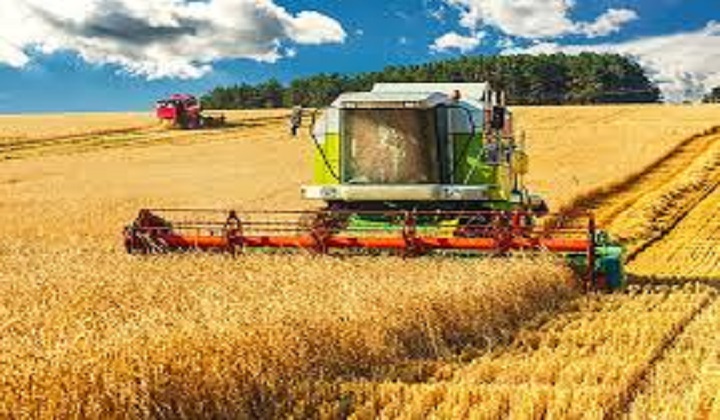Introduction
Seeds come in an immense variety of shapes and sizes. Small grains include wheat and rice as well as small and slippery oilseeds such as flax and canola. Large seeds include grain corn with seed on ears, soybeans, and other beans in pods. Plant height varies from ground-hugging peas to elevated ears on tall cornstalks. Such wide variations create unique demands for harvesting machinery. All these crops from oilseeds, grass, and clover seeds to large fava beans are mechanically harvested with combines and mechanical threshers. The term “grain” will be used here to include all types of seeds.
History
Until the nineteenth century, most grains were harvested by cutting with a sickle or scythe, then manually flailed or beaten to break the bond of the grain with the stalk, then winnowed to separate the grain from material other than grain (MOG). In the developing world, these practices or the use of small stationary threshers are still in use for rice and another grain harvesting. Stationary threshers emerged at the time of the Industrial Revolution.
The design generally used a tangentially-fed rotating cylinder to beat material and break the bond between grain and stalk, followed by a screen or sieve that allowed smaller grain pieces to pass through and separate the grain from MOG. Those threshers were powered by humans, animals, or water and later by engines. During the nineteenth century, mechanical reapers and binders were developed to cut and windrow grain for field drying.
The sheaves were then hauled to stationary threshers. Around the start of the twentieth century animal-drawn machines, “combines,” were developed that integrated cutting, threshing, and separating wheat and small grains. The necessities of World War II hastened the adoption of self-propelled combines. Corn was initially harvested by hand-picking ears after drying in the field. Such manual corn harvest was labor-intensive.
Early in the twentieth century, Grandpa Sallee hand-picked about 0.4 acres per day. The important job of the harvest was a family affair (Grandma Sallee would get a kiss if she found a rare ear of corn with red grain during hand picking)
Mechanical ear corn pickers were commercialized in the United States during the 1930s and had been commonly adopted by World War II when labor was scarce. Prior to World War II, the processing components on small grain combines were not yet rugged enough to harvest corn. Corn pickers were either pulled by tractor or tractor mounted.
Snapping stalk rolls that pulled down cornstalks and snapped off ears were necessarily aggressive but not shielded. Many farmers lost an arm or hand or were caught in the rolls while trying to unplug stalks with the picker still running. Snapping rolls were later shielded by stripper or deck plates. Ear corn was commonly stored and further dried by natural air in a crib with gaps between sideboards. Corn was fed locally to livestock or threshed by a stationary thresher before entering the commercial grain trade.
Although seed corn is still commonly mechanically harvested by ear followed by carefully controlled storage, then stationary threshing of seeds from the ear at a central location, handling the full ear doubles the amount of material that must be stored and handled. In the 1960s, advances in artificial corn grain drying, and more rugged threshing and separation components in combines, transformed corn harvest from ears to field-shelled grain
Machine Design: Pre-harvest Issues
Harvest equipment design criteria and operation are affected not only by the type of crop but by the limited time available for harvest and cultural practices associated with the crop. Grain and oilseeds rapidly mature in just a few days before harvest. Grain moisture content drops rapidly as the plant matures. Unless the grain is artificially dried, harvest is delayed until the moisture content is low enough to avoid spoilage during the time the grain will be in storage.
However, if seeds and plants are left in the field too long, pre-harvest field losses occur from storms, lodging plants, or rain falling on the ground. Also, growers are financially penalized for selling grain if the moisture content is less than that of official market grain grades. In some crops, re-wetting by rain also can create storage and/or quality problems.
Optimal field harvest conditions are governed by the weather. This creates considerable pressure to complete harvest in a short time period before the crop is lost in the field or spoilage occurs. For rice, that optimum period maybe just three days. Cultural practices affect harvest conditions. Stalk strength (small grains, corn) or seed placement on the plant (beans) differs with variety or hybrid. The date of planting and approximate days to plant maturity affect how quickly a crop will be ready to harvest.
Densely planted populations may promote stalk lodging. Row spacing determines corn head geometry. If weed management strategies have not been effective, large green weeds can overload and plug harvest equipment. The machine design has to cater to all these conditions. Grain end-user requirements also influence harvesting equipment design and settings. Visit Gramhir to find out more information
Conclusion:
Grain may be used for livestock feed, human food, fuel (e.g., ethanol production), seed, industrial, or other purposes. Grain damage occurs during threshing, separating, and han94 Farm Machinery Design dling. Unless grain is used immediately for livestock feed, most grain buyers want damage limited to a prescribed standard.
Besides a general market standard, the buyer may require a lower damage level for particular uses. Grain may also need to be segregated or “identity-preserved” for some uses (e.g., seed, food, higher-value industrial uses) and that demands a thorough clean-out of the combine before harvesting another crop.




